Instead of making a standalone Cooper CS5 Ultra Touring review, or Cooper CS5 Grand Touring review, due to their similarities, I decided to compare them in one article.
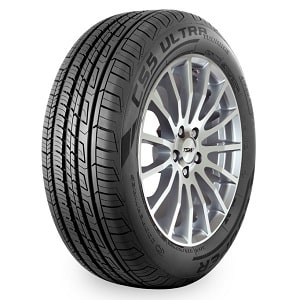
Cooper CS5 Ultra Touring
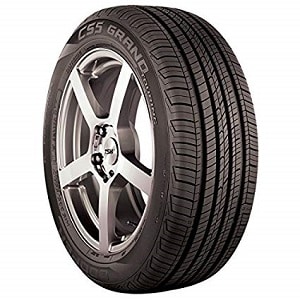
Cooper CS5 Grand Touring
High-performance summer tires may be great if you want the highest possible velocities in the corners, but for most people handling prowess is not the first thing they look for in a tire. Most of the vehicle owners around the world want tires that will be safe and last for long periods of time. High-performance tires are much safer than any other alternative in dry conditions, and some of them in wet conditions, but they completely fall apart when the temperature goes down.
That’s where touring tires come in. Available in several different configurations, these tires are almost always of the all-season variety, which means that they work in a wider range of temperature conditions. They are also much more durable than summer tires, with double the treadlife when compared to summer tires. Oh, and on top of that, they are less expensive. There are other traits that touring tires have that suit the casual driver, such as very low noise on the highway and comfortable ride over bumpy surfaces.
These qualities make touring (and in extension Grand Touring and Ultra Touring) tires the best choice for sedans and compact cars. And one of the most popular choices in this category is the Cooper CS5 Grand Touring and Cooper CS5 Ultra Touring. Both tires serve similar purposes, but they are still aimed at slightly different buyers.
Instead of making a standalone Cooper CS5 Ultra Touring review, or Cooper CS5 Grand Touring review, due to their similarities, I decided to compare them in one article. In this detailed comparison, you can see how they measure in several different categories, including dry, wet, and snow traction and performance, and also in the durability and comfort departments.
But first, let’s have a deep look in both products and see what are the differences according to Cooper Tire.
1. Cooper CS5 Overview
Both the Ultra Touring and Grand Touring models are all-season, so they should work in warm or cold weather, and in dry, wet and snowy conditions. There are however differences between them, especially in the tread design.
1.1 Cooper CS5 Grand Touring Review
The Grand Touring is the more expensive tire of the two, but the differences are very small and may be neglected by most buyers. According to Cooper, this is a standard all-season touring tire developed for drivers of coupes, sedans, and crossovers looking for a comfortable ride and confident traction in all weather conditions, including light snow.
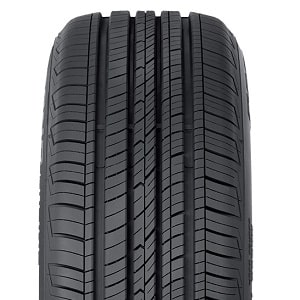
In order to achieve all those attributes, the Cooper CS5 Grand Touring is made of Coupled Silica compound. The tread is asymmetric, which means that the owner can rotate the tires from side to side to combat uneven wear. Then, for better handling, Cooper incorporated outboard shoulder blocks with larger tread blocks and less void area. Wet traction is aided by ribs and inboard shoulders with high sipe density, lateral grooves, and more open space. Cooper rounds-up the all-season moniker with full-depth 3D Micro-Gauge siping on the entire tread depth that creates biting edges for better grip and traction in low-friction surfaces, such as light snow.
The internal construction of the tire consists of a high-turnup, single ply polyester casing, with two steel belts that serve as support. As with most tires, spirally wound nylon reinforcement boosts handling and high-speed stability.
The speed rating of Cooper CS5 Grand Touring is “T,” or highest velocity of 118 mph. It comes with a treadlife warranty of 80,000 miles, which is one of the best results in its class.
1.2 Cooper CS5 Ultra Touring Review
The Ultra Touring model is slightly cheaper, despite having a higher speed rating. However, it also comes with a shorter warranty – 50,000 miles for W-rated models (168 mph) and 70,000 miles for V-rated (149 mph) and H-rated (130 mph) models. Cooper says that this is a standard all-season tire for owners of coupes, sedans, and crossovers, with an accent on comfort, agile handling, and an ultra-quiet ride.
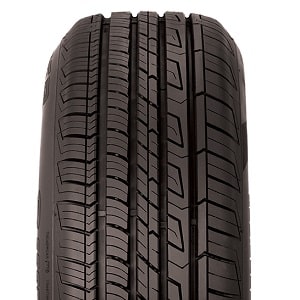
As with its Grand Touring brother, this model is equipped with the new generation coupled silica tread compound that provides powerful all-season traction and braking performance. The four-times higher silica compound than the CS4 predecessor also lowers the rolling resistance, helping the vehicle achieve better fuel economy.
Then, the Stabiledge technology promotes precise steering feel and enhanced responsiveness in the corners, while the asymmetric design helps to reduce wear thanks to more rotation options. Interestingly, the Ultra Touring model has a wear square visual tread indicator, that shows the owner when it’s time to replace the tires.
Like the closely-related Grand Touring tire, the Ultra Touring has 3D Micro-Gauge siping that creates biting edges for better grip and traction in low-friction surfaces, such as light snow.
2. Detailed Review of Cooper CS5
Treadwear and Durability
Perhaps the most important criteria for the general buyer, treadlife is something that most touring tires excel at. The same can be said for the Cooper CS5 Grand Touring and CS5 Ultra Touring – both are very durable tires, especially if used properly. Nonetheless, there are differences between them in this category on which the buyer should pay attention.
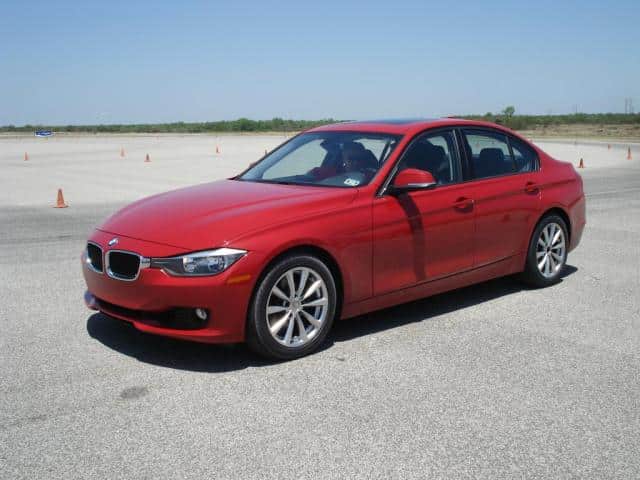
The Grand Touring has a longer treadlife, with a tread that can last around one year more than the Ultra Touring tire. However, that is only if you use it on less powerful cars that achieve lower velocities. In other words, if you own a car with a four-cylinder engine, the Grand Touring will last for years without the need of replacement
The tread of the Ultra Touring model, on the other hand, may not last as long when compared to the Grand Touring, but that’s only at lower speeds. This tire has a higher speed rating, which means that it will keep its shape better at higher speeds. So, if you own a more powerful vehicle, say with a V6 engine, you might get longer treadlife with this tire.
Still, the CS5 Grand Touring is directly aimed at buyers who want a dependable and durable tire, which is shown in the 80,000-mile tread warranty, compared to 70,000 miles of the other one. This gives it a slight edge over its brother in my opinion, despite the fact that the Ultra Touring is tougher and can withstand higher speeds.
With the Grand Touring, you will simply forget when was the last time you replaced your tires – it is one of the longest-lasting tires on the market right now. Thanks to that, it gets the highest possible score here, while the Ultra Touring finishing a close second.
Rating Verdict
Cooper CS5 Grand Touring – 90
Cooper CS5 Ultra Touring – 85
Dry Traction and Grip
You might think that modern tires have are almost regularly great in dry weather, but you would be wrong. Most cheap tires aren’t, and there are even some more expensive ones that should do better.
Luckily, the Cooper CS5 Grand Touring and Cooper CS5 Ultra Touring don’t fall into that category. They are not only good in dry conditions – they are among the best in their respective categories.
Traction is excellent in both tires – even some more powerful vehicles will have their wheels glued to the floor when accelerating out of a corner. The grip is also very good, even at the limit, up to the level of the best premium touring tires. And don’t worry about safety – braking distances are very short with both tires, again on the level of the best in this class.
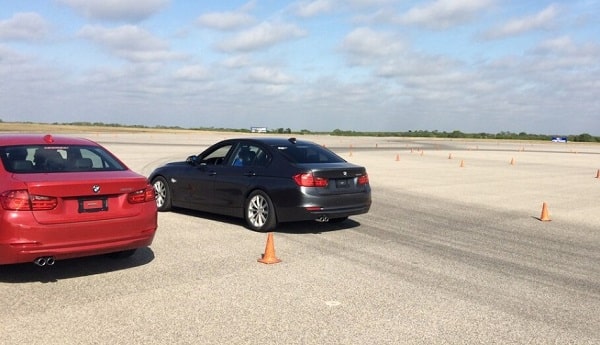
With all that said, there are differences between both tires and they are not small. The Grand Touring model is the lesser in this department. It is very safe and should offer its owner care-free driving experience, but it isn’t well-suited to high-performance vehicles. Even though it is among the best in its category, the CS5 Grand Touring isn’t as responsive in the corners. Owners of V6 vehicles, for example, will search for traction if they step on the pedal out of a corner, while driving enthusiasts will surely want more precise steering control. Don’t get me wrong – the Grand Touring is still a great tire in its own right in dry conditions, but the Ultra Touring is simply better.
That is apparent even in the first corner I took with this tire. The car responds immediately to the steering input, and the feeling behind the wheel is like you’re driving a go-kart. The grip is much higher in the corners too, and the tire reacts better under stress or at the limit. In the end, the CS5 Ultra Touring has absolutely no problem putting the power of a V6 engine down on the road, and it offers better stability at higher speeds.
Overall, while the CS5 Grand Touring is a very good tire in dry weather, the CS5 Ultra Touring is a step up and clearly the better choice for more aggressive drivers or more powerful vehicles. I would go as far as to say that somehow reminds me of a high-performance tire in some of its qualities – great outcome for a touring model!
Rating Verdict
Cooper CS5 Grand Touring – 85
Cooper CS5 Ultra Touring – 90
Wet Traction and Grip
At first glance, the Cooper CS5 Grand Touring seems like it has more prominent tread, which should help it in the rain. And while it is true that it offers excellent performance when it is raining, it loses from its brother again in this category. Still, when compared to other tires in this category, I am positive that it is better.
Traction is very good in both light and heavy rain, up there with the best in its class. That is especially true if you compare it to vehicles in its price class, or manufacturers like Hankook and Kumho, both of which suffer from much less traction in wet conditions.
Braking distances with the CS5 Grand Touring will also be much shorter, both in wet and damp conditions, and the car will feel safer overall behind the steering wheel.
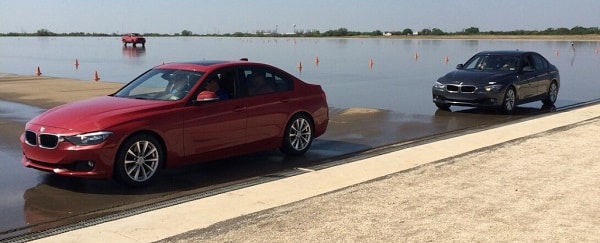
That is until you try the Cooper CS5 Ultra Touring. Even though the tread doesn’t seem as prominent, this model offers much better traction and grip, especially in damp conditions (the Grand Touring is closer in heavy rain). This is perhaps earned because of the higher-quality compound, but that’s only a guess. What I can say for sure is that the Cooper CS5 Ultra Touring offers wet traction that is among the class leading in the category (higher-performance touring tires). Braking distances are also very short, and the tire seems like it has outstanding grip in the corners, with great adjustability even at the limit.
I don’t want this to sound bad for the CS5 Grand Touring, but its brother again takes the victory in this category. It offers better traction and grip, and shorter braking distances. That said, you may still expect great results from the CS5 Grand Touring – most tires in its category are much worse and less safe in wet conditions. Still, if you’re interested only in the best, the CS5 Ultra Touring is a better choice for those rainy days.
Rating Verdict
Cooper CS5 Grand Touring – 80
Cooper CS5 Ultra Touring – 85
Snow Traction and Braking Performance
Both tires are rated as M+S, which means that they can be used in the winter, even when it snows. That is the case with most all-season tires that are sold today if not all of them. Still, I would recommend all-season tires for winter duties only if you live in areas with mild winters and light snow occasionally. Winter tires will still offer much better traction and shorter braking distances, which makes them a much safer solution for vehicle owners.
With all that said, how do the CS5 Grand Touring and CS5 Ultra Touring compare in the winter? I would say that in this category the Grand Touring is slightly better, but only just. The difference is still very small and shouldn’t be important to buyers of this tire. If you want better winter performance, you will be better served elsewhere. That’s why I started this category by telling you about the advantages of winter tires when compared to other types.
And the differences I am telling you about are perhaps only measurable on a test track. The CS5 Grand Touring does have slightly better traction when accelerating and shorter braking distances, but it is still not very good. The CS5 Ultra Touring is slightly worse, but it’s the same with every tire that gives you better performance in dry and wet conditions.
In cold weather without snow, both tires show excellent results in traction and braking distances, especially after they warm up a little. Thanks to the pliable material they are made off, both the CS5 Grand Touring and CS5 Ultra Touring are perfectly safe for driving in cold and dry weather. Some tires in this category might be better in very cold weather, but the differences are small, and their price is higher.
Rating Verdict
Cooper CS5 Grand Touring – 70
Cooper CS5 Ultra Touring – 75
Comfort & Noise
Given the fact that both models are touring tires, it is expected from them to perform highly in this category. And indeed they do! Cooper CS5 Grand Touring and Cooper CS5 Ultra Touring have tread that is designed with quietness in mind, something that is especially felt when they are installed on some cheaper vehicles. Even at higher speeds, both tires emit much less noise than expected in this price class, and comparable to the likes of Michelin and Bridgestone. This is very high praise for both models and a result of the great progress Cooper Tire has made in the last decade.
But, what about comfort? Again, both tires are very comfortable and iron out a lot of the bumps on the road. When testing them side by side, I found out that the CS5 Ultra Touring is slightly more comfortable, but really, the difference is so small that it might be just a personal error in judgment. When compared to other tires in this category, the CS5 Grand Touring and CS5 Ultra Touring measure favorably, especially with models that are in the same price range.
Overall, both tires are one of the best on the market right now for comfort and quietness. I highly recommend them if you make a lot of highway trips and value the luxurious feeling they would give.
Rating Verdict
Cooper CS5 Grand Touring – 90
Cooper CS5 Ultra Touring – 90
Design
Most buyers don’t care about the design of their tires, but there are some owners of sportier vehicles who want tires that will suit the aggressive design of their car better. Design is a very subjective thing and comparing these tires in this category is only my personal opinion, so keep that in mind before attacking me for my decision. And my decision is that the CS5 Ultra Touring is the better-looking tire, specifically on the outer edge, where it looks almost like a summer tire. Not that the CS5 Grand Touring is bad, mind you.
Rating Verdict
Cooper CS5 Grand Touring – 80
Cooper CS5 Ultra Touring – 85
3. Comparison with other tires
Cooper CS3 vs. Cooper CS5
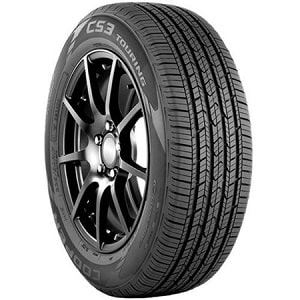
If you are thinking between the CS3 and CS5 class of tires, you should first ask yourself how much you’re prepared to pay, as the CS3 will be cheaper. However, the CS5 does offer several benefits in almost every category.
First of all, you should expect better traction in dry and wet conditions, especially if you opt for the CS5 Ultra Touring.
Then, the CS5 Grand Touring has longer treadlife at 80,000 miles’ warranty, compared to 65,000 miles for the CS3. Both the CS5 Grand Touring and CS5 Ultra Touring will be quieter on the highway too, even though the CS3 is no slouch in this category.
Overall, I think that the CS5 series tires offer enough benefits to warrant the higher price, especially for owners of newer vehicles. That said, the Cooper CS3 is still not a bad choice by any means. Owners of older compact cars that don’t cover many miles annually will certainly have no objection at the slightly worse traction and shorter treadlife.
Cooper CS4 vs. Cooper CS5
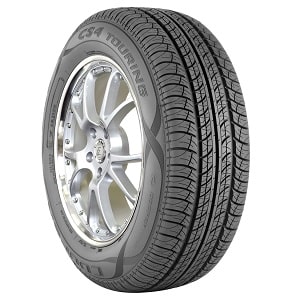
Even though it might seem like they belong to a different category, the reality is that the CS5 is the successor to the CS4. This almost universally means that it should be the better tire. In my testing, the CS5 is not only better – it simply destroys its predecessor. The biggest difference is probably the tread compound, which has four times the amount of silica inside.
Thanks to this, the CS5 is miles better in wet conditions than the CS4. In areas where the older tire loses grip and traction, the newer one just keeps going forward. The difference in dry conditions is not that big, but it is still noticeable even by the average driver. Braking distances with the CS5 will also be shorter when compared to the CS4 – great news for safety. Snow performance might be slightly better with the CS5 too. The newer model is also quieter and smoother on the road, and on top of that, it is more durable.
It is safe to say then that the Cooper CS5 (both versions) is a much better choice than the tire it replaces. I wholeheartedly recommend going for it newer model as it offers improvements in almost every field and shows how much Cooper Tire has grown as a manufacturer.
Cooper CS5 Grand Touring vs. Michelin Defender

Here we have the CS5 Grand Touring compared to one of the most popular tires for passenger cars and minivans, the Michelin Defender. I’ll start here by saying that Cooper Tire almost touches the Defender in the durability category, which is spectacular given the lower price – even their warranties are the same. Performance on the road is perhaps slightly worse for the CS5 Grand Touring, both in dry and wet conditions, but the differences are very small here. In the winter, both tires seem to be neck-and-neck. As for comfort and quietness, I think that the CS5 Grand Touring is slightly better, which is again a testament of how much has this company progressed. Most importantly, when you put the price in the equation, the CS5 Grand Touring seems like the better choice, as it can save you up to $100 for a set of four tires.
Cooper CS5 Ultra Touring vs. Michelin Defender
Everything that I said about the Grand Touring model when compared to the Defender is turned upside down here, except durability, where the Michelin is again the champion in its category. In the performance department, the CS5 Ultra Touring shows better results in both dry and wet conditions, with snow traction maybe slightly worse than the Michelin. Quietness and comfort are also better than what the Defender offers, and the price is lower. If you value long-lasting treadlife, the Defender might be a great option, but the CS5 Ultra Touring is better in almost every other category.
Cooper CS5 Ultra Touring vs. Michelin Premier A/S

The CS5 Ultra Touring might have won against the Michelin Defender, but it has a much tougher job when compared to the Premier A/S. This is one of the most popular Michelin tires out there, due to the fact that it offers the best wet performance in its class, even when it is worn down. This is achieved thanks to the Michelin EverGrip technology with Expanding Rain Grooves around the tire’s circumference and Emerging Grooves across the shoulders.
So, the Michelin is better in wet conditions, but how do they compare on dry roads? The answer is again that the Premier A/S is better, but this time with the smaller disparity between the two. The French tire is also better in the snow, with the two being neck-and-neck in the quietness and comfort department. As for durability, it seems that Michelin is always on the top – it simply destroys the CS5 Ultra Touring here with its 80,000 miles’ warranty, compared to only 70,000 miles.
These results are not surprising – the Michelin Premier A/S is much more expensive than the CS5 Ultra Touring – it might cost you well over $100 for a set of four tires! If I was making the decision here, it depends on the vehicle I would’ve owned at that time. If it was a premium vehicle with a more powerful engine, I would’ve chosen the Michelin. However, if it was a sedan or a minivan, then my choice would’ve been the Cooper.
Cooper CS5 Grand Touring vs. General Altimax RT43

Here we have two tires that are directly comparable due to the similar price points. Both are very popular in the USA thanks to the combination of performance and low price, but which one is better? In my opinion, the CS5 Grand Touring is better in dry and wet conditions, but only just – the General Altimaxt RT43 is still very good here. Comfort is where the RT43 fights back – it simply glides over obstacles on the road. In the quietness department, they seem to be neck-and-neck – both are very quiet. Things stay the same on snow – both tires are just marginal.
That said, the CS5 Grand Touring clearly gets the win in the durability department. It is not only more durable, but it also offers a higher warranty – 80,000 miles’ compared to 75,000 miles. For me, this is enough to recommend it over the General Tire equivalent.
4. Frequently Asked Questions (FAQs)
When should Cooper CS5 Ultra Touring tires be rotated?
It is recommended that you rotate the tires on your vehicle every 6-8,000 miles, or every time you change the oil. By doing this, you will ensure that the tires will last longer and wear evenly. Please note that the CS5 Ultra Touring tires can also be rotated from side to side, so make combinations of that type of rotation with back to front.
What is the speed rating of the Cooper CS5 Ultra Touring?
Depending on the size you choose, the CS5 Ultra Touring is offered in three different speed ratings. The smaller models are offered in “H” speed rating (130 mph), the middle of the pack has a “V” rating (149 mph), while the biggest models have “W” rating (168 mph). Please note that W-rated models have an only 50,000-mile warranty, compared to the 70,000-mile warranty for the other two.
Where is Cooper CS5 Ultra Touring Tires Made?
Cooper Discoverer SRX tires are made in the USA, in four different plants – Albany (Georgia), Tupelo (Mississippi), Findlay (Ohio), and Texarkana (Arkansas).
What is the mileage warranty of the Cooper CS5 Grand Touring Tire?
The Cooper CS5 Grand Touring comes with 80,000-mile treadwear protection, with a free 45-day road test.
What is the tread depth of the Cooper CS5 Ultra Touring Tire?
Cooper rates the CS5 Ultra Touring at 11 tread depth measured by 1/32″.
How many plies does the Cooper CS5 Ultra Tire have?
Considering the fact that this is not a tire that’s designed for towing or hauling, you really shouldn’t care much about the ply rating. However, for your information, this model is available in STD and XL load ranges. It is also made of a single ply polyester casing beneath two steel belts.
What is the recommended tire pressure of CS5 Grand Touring?
The tire pressure depends on the specifications provided by the manufacturer of the vehicle, and not by the manufacturer of the tires. It also differs greatly from one size of the tire to another. That’s why always follow the data imprinted on your vehicle.
5. Cooper CS5 Review: Final Words
Choosing between two very similar products is always a chore, especially when they are similarly priced and made by the same manufacturer. However, the CS5 Grand Touring and CS5 Ultra Touring have some differences and are aimed at a different type of buyer.
The CS5 Grand Touring is the better choice for owners of compact vehicles or sedans who want a durable and dependable tire that will work in almost every condition. The CS5 Ultra Touring, on the other hand, is a better choice for owners of more powerful vehicles who value traction and grip more than long treadlife.
Both are a great choice in their respective categories, especially given the fair price, and show that Cooper Tire has become a serious contender in the congested premium touring tire sector.
Thanks for reading and I hope you found this Cooper CS5 review helpful. If you have any questions or comments please feel free to leave them in the comments section below.